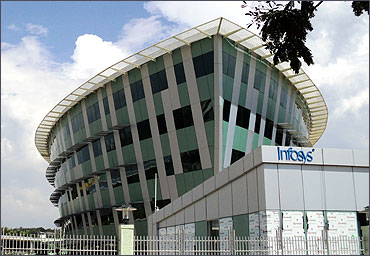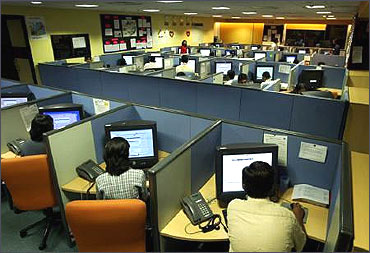Shivani Shinde in Mumbai
A fundamental shift is about to take place in the IT services landscape.
The glory days where IT firms like TCS and Infosys posted soaring margins of 28 to 30 per cent may just be over.
While these companies maintain that they can still sustain such high numbers, analysts have already factored in a drop of two to three per cent over the next two to three years.
Troubled times
The drop in margins mirrors the uncertain times that these companies are doing business in - especially in countries like the United States where job growth has stagnated and the economy is crawling along at around 1 per cent GDP.
Added to these woes are increased cost structures and currency volatility.
If the macro situation deteriorates further, the drop will be even more significant.
This could mean delayed sales cycles, deal ramp-down and further price cuts - all of which could spell relative doom for an industry that lives and dies by its margins.
Click on NEXT for more...
Is the high margin story over for Indian IT firms?
Photographs: Courtesy, Cognizant
Apart from the macro problems, however, the rosy margin picture is being tainted by other more industry-specific ailments.
Increasing employee costs is one.
The inability to break the link between employees and revenues is another.
Moreover, there have been no substantial increases in pricing since 2007.
Tack on increased pressure to hire more locals in majority markets such as the US, visa fee hikes and tough competition from multi-national players who have got their off-shoring strategy in place and you have a potential firestorm brewing.
On the other hand, domestic peers like Cognizant and HCL have done fabulously well -growing over 30 per cent on a year-on-year basis - despite consciously keeping their operating margins well below the 20 per cent range.
This, analysts point out, has allowed both the firms to invest more in their businesses and gain market share.
Click on NEXT for more...
Is the high margin story over for Indian IT firms?
Image: TCS building.The Indian IT services firms have historically managed to have 'Earning Before Interest, Taxes, Depreciation, and Amortisation' (Ebidta) margins in the range of 27 to 30 per cent.
That changed for the small and medium firms as recession hit their revenues and profitability.
However, the top tier firms, especially Infosys and Tata Consultancy Services (TCS), managed to hold on.
In fact, TCS - which has been able to grow its EBIDTA from 25.8 per cent in FY2009 to 30 per cent in FY2011 - has almost closed the gap with Infosys.
However, the quarter ending June 30, 2011 was a different story and portends dark clouds for high- margin players.
Infosys' EBIDTA margins dropped by 297 basis points (bps) to 29 per cent compared to the previous quarter.
Meanwhile, although TCS improved its margins for the June quarter unlike Infosys, they were down by 213 bps compared to the previous quarter to 28.1 per cent.
The primary reason for plummeting margins in both cases was salary hikes.
Click on NEXT for more...
Is the high margin story over for Indian IT firms?
Image: Infosys campus.Maxing out efficiency levels
So far, the top tier firms have managed to sustain high margins by using cost efficiency levers - techniques to wring the most out of a business contract by pushing work to cheaper offshore centres, hiring more sub-contractors and making sure that as few people are sitting in the wings while getting trained or waiting for work.
Currently, most firms have 70 per cent of their employees working off shore, with 30 per cent of them on-site.
TCS and Infosys are both talking of utilisation percentages in the range of 80-82 per cent which means that the rest comprises of senior management, employees in admin and a few more on the bench.
Problem is neither of these categories are able to bill for their time.
"So far, the Indian firms have managed to maintain their margins by improving their efficiencies," says Siddharth Pai, managing director, TPI India.
"This is evident in the high utilisation percentage and hiring of younger resources over the last few quarters. But these are not structural changes, they are just to help build efficiency," he adds.
Plus, while MNC players have begun capitalising on their global footprint as well as consulting-led expertise, this is an area that remains a major Achilles heel for Indian tier one players, say analysts.
Click on NEXT for more...
Is the high margin story over for Indian IT firms?
Image: Employees at a call centre in Bangalore.Photographs: Sherwin Crasto/Reuters
Rising costs
While Indian players have been working on their non-linear strategies, like platform-based BPO product and solutions for instance, these initiatives will start generating revenue only after two or three years.
Analyst also believe that if the top three firms continue to grow at 20 per cent with the same productivity level they will need to hire over a million people which will further increase their employee costs - currently 50-55 per cent of total costs at any IT services firm.
Add to this changing visa fee structures, rising unemployment in the US and increasing pressure to higher locals, and this spells a sea change in the cost structure.
"With over 90 per cent of employees in US already on L-1/H-1B visas, stricter visa procedures/regulations could force Indian Techs to hire more locals at a pace faster than they are doing right now, impacting margins and operational flexibility," says Nimish Joshi in a CLSA report.
Click on NEXT for more...
Is the high margin story over for Indian IT firms?
Image: A man puts a piece of foreign currency back in his wallet.Photographs: Jim Bourg/Reuters
Companies feel that salary hikes can be controlled if there is enough business opportunity and a resultant price increase. But the pricing level within the industry is yet to touch the 2007 level.
"Pricing is stable. But they are still not at the 2007 level," says S Mahalingam, CFO, TCS.
"Post Lehman, companies were battling cost-cutting and clients asked for pricing cuts. There have been some pricing cuts but many of these companies are yet to come out of the recession. So I cannot go and ask for a price hike," he adds.
A salary hike - which hasn't happened since 2008 - could also put a huge dent in the budget of these IT companies.
Click on NEXT for more...
Is the high margin story over for Indian IT firms?
Photographs: Nir Elias/Reuters
Future for margins
Not surprisingly, Ashwin Mehta, Research Analyst at Nomura thinks that Ebitda margins for IT biggies will decline by 80-200 bps overall over FY11-13F (versus consensus expectation of margin stability).
"We think growth investments would be necessary for growth to be ahead of 25 per cent in FY12 and beyond.
However, in this phase of growth there would be less buffer for margins on account of supply-side constraints, exhausted operational scope and inconclusive pricing improvements, in our view," he says in his report.
Click on NEXT for more...
Is the high margin story over for Indian IT firms?
Of course, all concerns of a margin fall vanish if Indian IT firms continue to see volume and pricing improvement. V Balakrishnan, Chief Financial Officer of Infosys is a believer.
"It is possible if growth comes in. I do not think the model will change - which means it will still be 70:30, with 70 per cent offshored and 30 per cent onsite," he said.
Mahalingam of TCS agrees. "We have stated that we can maintain margins at 27 per cent. The strategy is to have a band within which we need to manage our cost. This will also take into account wage hikes, or our local hiring in overseas market," he says.
However, life on the margins is not an easy business and the coming years will be sure to strain this kind of optimism to the maximum.
With inputs from Sheetal Aggarwal










article